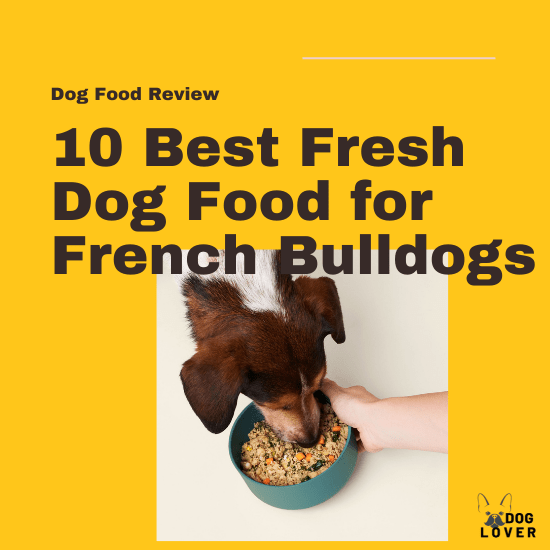What are the best dog foods for Pugs?
Pug owners often describe their pets as unique companions, full of mischief and charm.
However, being brachycephalic, Pugs face breathing challenges, especially during mealtimes, which can lead to choking due to their tendency to gulp food and air simultaneously. This can also result in those adorable yet stinky farts.
Pugs are prone to obesity since they may not recognize when they’re full, making it essential to monitor their intake.
Dividing their daily food into three meals can help prevent overeating. While some owners opt for homemade meals, it requires careful planning to ensure nutritional balance, so consulting a vet is crucial.
Fresh meal delivery services and options like freeze-dried food or holistic kibble are alternatives that cater to their specific needs.
Always be cautious about their diet, as Pugs can be sensitive to various foods, and watch for any signs of allergies.
What Are the Six Essential Nutrients Your Pug Needs?
Before exploring our recommended dry, low-fat, fresh dog foods, it’s essential to understand your Pug’s nutrient needs.
Many dog food labels claim to be “Complete and Balanced,” but what does that mean? Such products meet nutrient levels established by AAFCO for specific life stages, ensuring your dog receives all necessary nutrients.
The six essential nutrients for Pugs are:
- Water: Comprising 70% to 80% of your Pug’s body weight, access to clean water is crucial for bodily functions, including nutrient transport, temperature regulation, and digestion.
- Proteins: Dogs require 23 amino acids to build tissues, 10 of which must come from dietary protein. High-quality proteins should be the first ingredient in their food.
- Fats: Essential fatty acids, such as omega-3 and omega-6, are vital for energy and maintaining skin and coat health.
- Carbohydrates: Plant-based sources like grains and vegetables provide energy, sugars, and fiber for healthy digestion.
- Vitamins: Important for growth and maintenance, vitamins like A, D, E, C, and B12 support immune function, antioxidant activity, and nervous system health.
- Minerals: Essential for bone formation, oxygen transport, and nerve function, minerals like calcium, iron, and zinc are crucial for your Pug’s overall health.
What to look for on your dog food labels
When selecting commercial dry or wet food for your Pug, pay attention to the ingredient labels.
Ingredients are listed by weight, with the first five making up 80% of the product. Look for high-quality proteins and whole ingredients at the top of the list.
Additionally, check the Guaranteed Analysis (GA) on the bag or can, which provides the minimum levels of crude protein and fat, as well as the maximum crude fiber.
This information helps you understand the nutrient composition of your Pug’s food, ensuring it meets their dietary needs.
The name game when decoding the label
The first five to ten ingredients on a dog food label indicate quality. Look for protein as the first ingredient, ensuring it’s a real source, like beef.
For a product labeled “Beef Dog Food,” beef must constitute at least 95% of the product; terms like “Beef Dinner” only require 25%.
What you want to see on your Pug’s dog food labels:
When choosing dog food, ensure real meat is the first ingredient.
Fillers like corn, wheat, or soy should be listed lower on the ingredient list.
If “meal” is included, it should specify the source, such as chicken meal or beef meal, rather than vague terms like poultry meal. Meal is concentrated and retains nutrients, so it can be beneficial.
Specific protein by-products, like beef by-products, can be nutritious; however, avoid general terms like by-product meals, as they may include lower-quality ingredients and lack transparency about their sources.
What you don’t want to see on your Pug’s dog food label:
If the food label includes terms like “with beef” or “beef-flavored,” it indicates a minimal percentage of real meat.
Watch for the same ingredient listed multiple times under different names, such as high fructose corn syrup and corn syrup, which can disguise high filler content.
This tactic allows manufacturers to obscure the true amount of fillers like corn, cornmeal, and ground corn.
Excessive fillers may not be suitable for your Pug. Additionally, avoid foods containing artificial colors, flavors, and preservatives, as these can be harmful and do not contribute to your dog’s health.
What Are Fillers?
Many dog foods, particularly kibble, contain fillers—bulky, starchy, and carbohydrate-rich ingredients that provide little nutritional value.
These fillers are often inexpensive and help manufacturers keep costs low.
Common fillers include corn, wheat, rice, unspecified by-products, potato protein, and pea protein.
While some view these ingredients as healthy, they can irritate dogs and cause allergies or sensitivities.
This focus on profit drives many dog owners to seek fresh alternatives. We have reviewed various options and recommend six dry dog food brands and three fresh food brands specifically for your Pug.
Best Dry Dog Foods for Pugs
- Best Kibble Overall: Wellness Complete Health Natural Dry Small Breed Dog Food Healthy Weight $49.98 per 12-lb bag = $4.16-lb
- Best Kibble for Pugs with Allergies: Natural Balance Toy and Small Breeds Dry Dog Food $34.98 per 12-lb bag = $2.92-lb
- Best Price-Effective Kibble: Blue Buffalo Wilderness Puppy Chicken Recipe Grain-Free Dry Dog Food $59.98 per 24-lb bag = $2.50-lb
Best Fresh Dog Foods for Pugs
- Best Overall: The Farmer’s Dog Fresh Dog Food Average Cost $3 per day
- 2nd Best: Ollie Fresh Wet Dog Food Average Cost $4 per day
- 3rd Best: Nom Nom Fresh Wet Dog Food, Average Cost $6 per day
Wellness Complete Health Natural Dry Small Breed Dog Food Healthy Weight
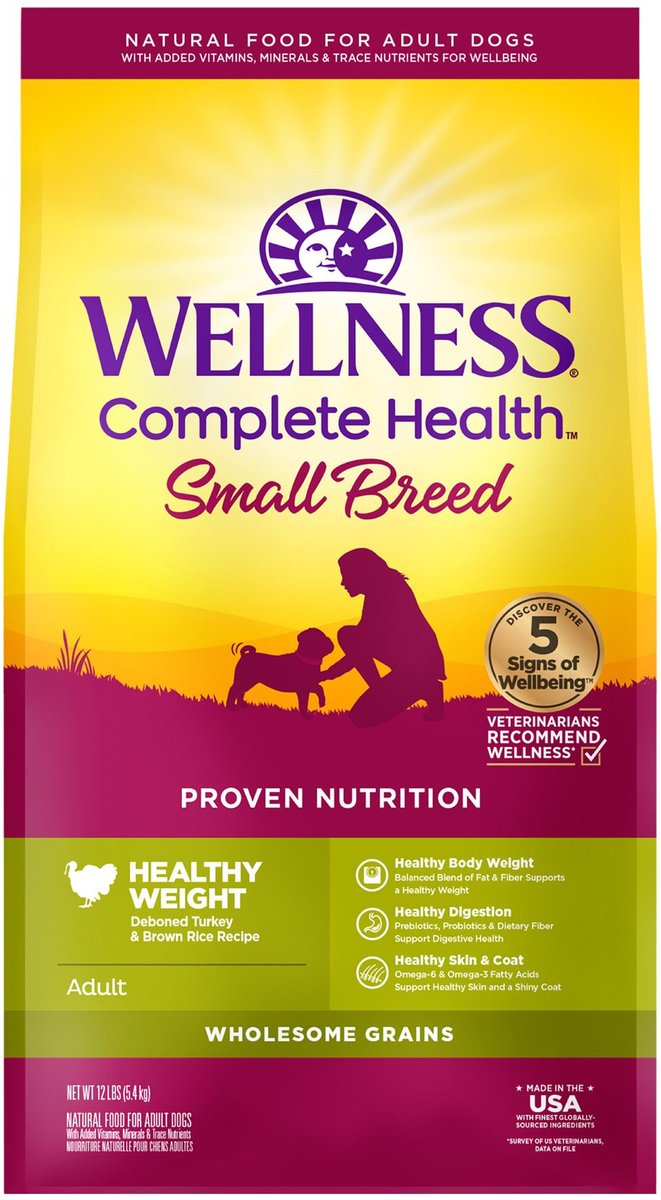
Wellness Complete Health Turkey & Rice by Wellpet LLC, founded in 1926, supports Pug weight management and health.
Its smaller kibble size eases eating for brachycephalic dogs.
Fortified with omega fatty acids, antioxidants, glucosamine, probiotics, and taurine, it has no GMOs, fillers, or artificial preservatives.
Highly recommended for Pugs, Boxers, and French Bulldogs.
- First 5 Ingredients: Deboned Turkey, Chicken Meal, Salmon Meal, Oatmeal, Rice
- Guaranteed Analysis: Crude Protein 28% min, Crude Fat 10% min, Crude Fiber 5% Max
- Calories: 341 kcal per 8-oz cup
- Suitable for which dogs: Extra Small & Toy Breeds, Small Breeds
- Feeding: 1¼ to 1½ -8-oz cups of food per day for adult Pugs to maintain a weight of 15 to 18 pounds. Pugs heavier than 18 pounds should get 1 to 1¼-8-oz cup of food per day. Remember to divide their daily food into three meals.
- Key Benefit: Designed to support healthy weight loss and maintenance using carefully chosen, expertly balanced ingredients.
- Price: $49.98 per 12-lb bag = $4.16-lb
Natural Balance L.I.D Limited Ingredient Diets Chicken & Brown Rice Formula Small Breed Bites

Natural Balance L.I.D. Limited Ingredient Diets Chicken & Brown Rice Formula is ideal for Pugs with allergies.
Made with farm-raised chicken and whole-grain brown rice, it includes omega-6 and omega-3 fatty acids for healthy skin and taurine for heart health.
This mid-priced, high-quality food has no controversial ingredients, artificial preservatives, colors, or flavors.
- First 5 Ingredients: Chicken, Chicken Meal, Brown Rice, Brewers Rice, Rice Bran
- Guaranteed Analysis: Crude Protein 23% min, Crude Fat 12% min, Crude Fiber 4.5% Max
- Calories: 335 kcal per 8-oz cup
- Suitable for which dogs: Toy, extra-small, and small breeds like Pugs, Boston Terriers and the Shih Tzu.
- Feeding: 1½ 8-oz cups of food per day for an adult pug between 18 and 20 lb (divided into 3 meals)
- Key Benefits: 100% free from added potatoes, chicken by-product meal, gluten ingredients, corn, wheat, soy, fillers and any other allergy triggers.
- Price: $34.98 per 12-lb bag = $2.92-lb
Hill’s Science Diet Puppy Small Paws Chicken Meal, Barley & Brown Rice Dry Dog Food
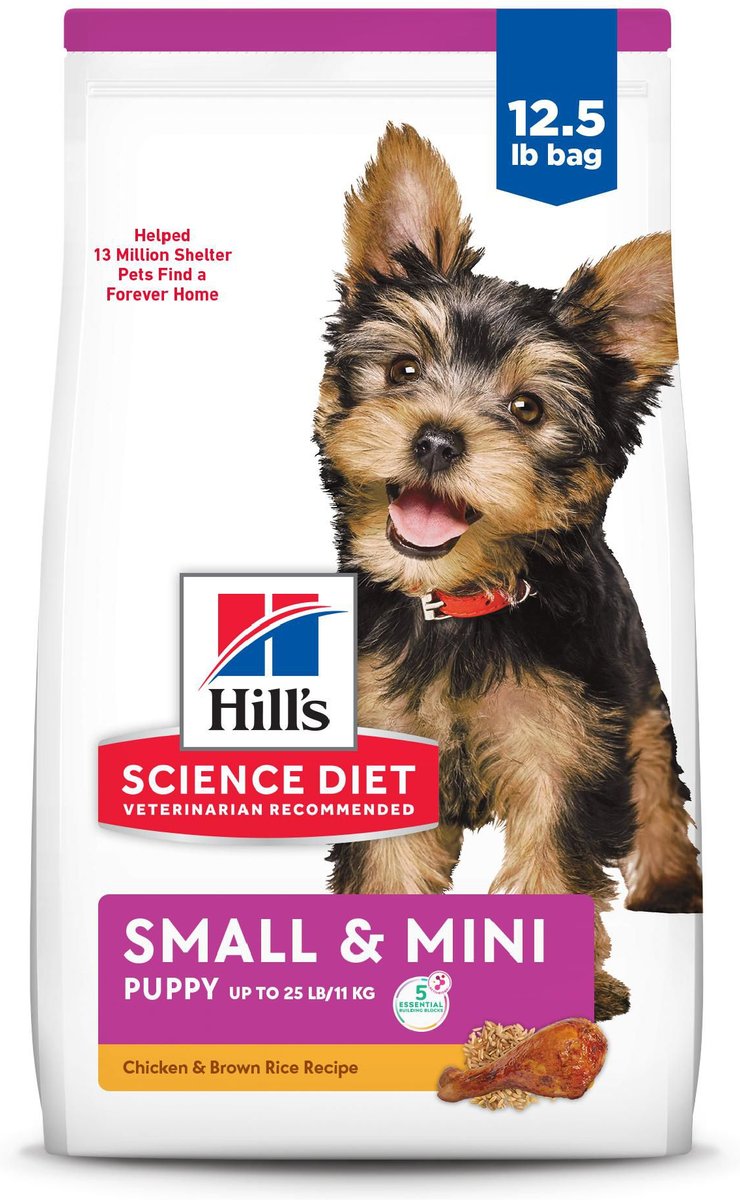
Hill’s Science Diet for Small and Toy Breed Puppies, launched in 1948 by Hill Packing Company and now under Colgate-Palmolive, offers precise nutrition for Pugs to avoid obesity.
With wholesome ingredients like chicken meal and barley, it supports healthy brain and eye development.
High in protein and fat, it’s ideal for small breed puppies and pregnant/nursing dogs.
- First 5 Ingredients: Chicken Meal, Whole Grain Wheat, Whole Grain Sorghum, Chicken Fat, Whole Grain Corn
- Guaranteed Analysis: Crude Protein 24.5% min, Crude Fat 15.5% min, Crude Fiber 3% Max
- Calories: 397 kcal per 8-oz cup
- Suitable for which dogs: Ideal for normally active Pug, Pekingese, Bulldog and other small breed puppies
- Feeding: Feed your pug puppy one ½ cup (8-oz) through months one and two, and ¾ of an 8-ounce cup through month three. Your precious Pug puppy should get closer to a weight of about 5 pounds, and be ready to start gradually transitioning to adult food through month four.
- Key Benefit: Antioxidants and vitamin E and C blend work together to help support a healthy immune system.
- Price: $38.99 per 15.5-lb Bag = $2.52-lb
Blue Buffalo Wilderness Puppy Chicken Recipe Grain-Free Dry Dog Food
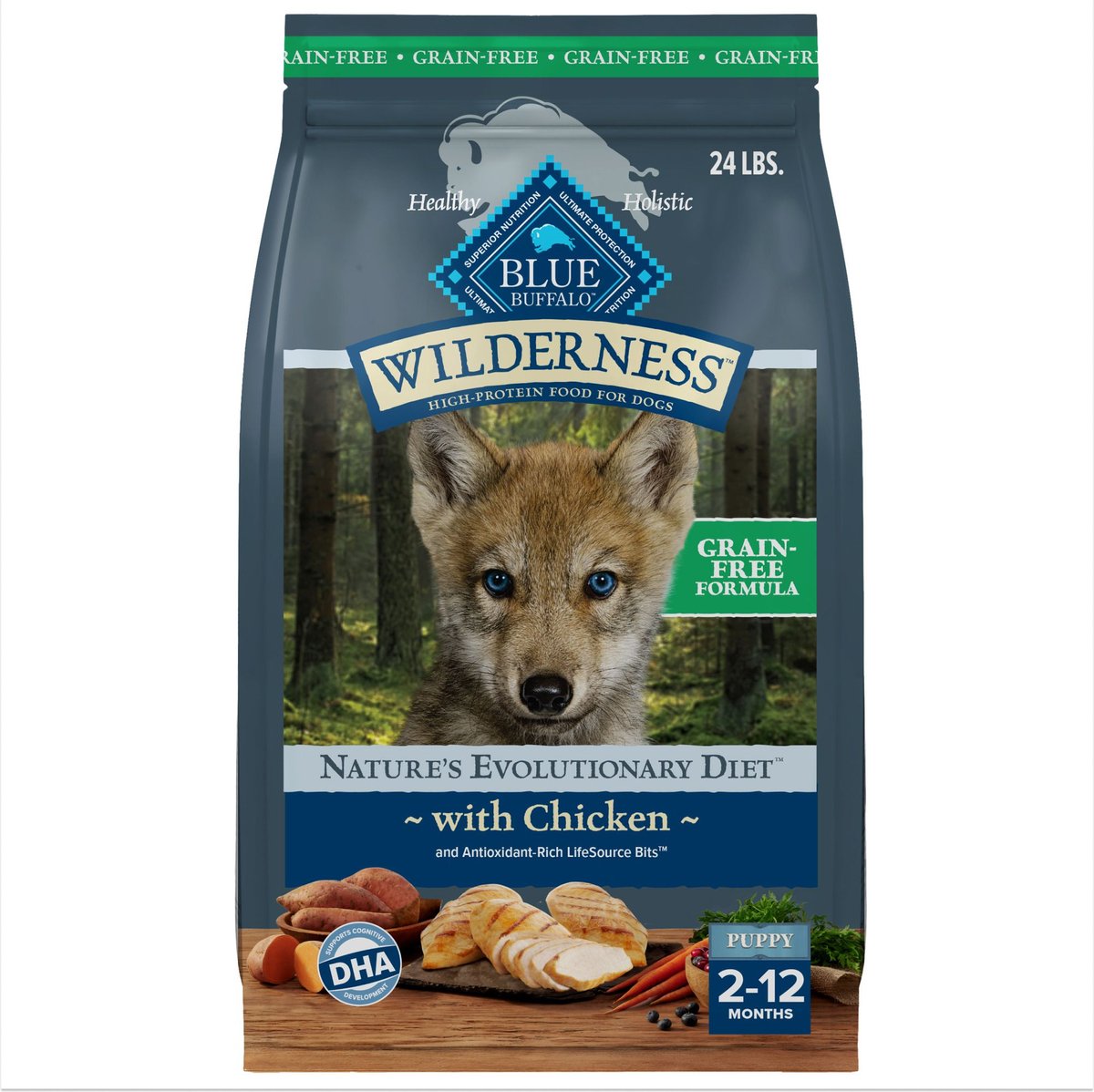
Founded in 2003 by Bill Bishop and his sons in honor of their dog Blue, Blue Buffalo was acquired by General Mills in 2018.
Blue Buffalo Wilderness High-Protein Grain Free, Natural Puppy Dry Dog Food, featuring real chicken, supports muscle growth and cognitive health with taurine, fatty acids, vitamins, antioxidants, and minerals.
Free from grains, corn, wheat, soy, and artificial additives, it’s affordable and high quality, making it our Best for Budget recommendation.
- First 5 Ingredients: Deboned Chicken, Chicken Meal, Pea Protein, Peas, Tapioca Starch
- Guaranteed Analysis: Crude Protein 36% min, Crude Fat 16% min, Crude Fiber 5% Max
- Calories: 423 kcal per 8-oz cup
- Suitable for which dogs: Puppies of all breeds, including brachycephalic dogs like Pugs, Pekingese, and Lhasa Apso.
- Feeding: ½ to one 8-oz cup of food per day for Pug puppies up to 3 months old, weighing up to 5 pounds. Healthy Pug puppies typically weigh between 5 and 9 pounds in the fourth month, when they should eat ¾ to one 8-oz cup of food per day. By month five, Pug Pups can start transitioning to adult food. (Remember to divide the day’s food into 3 or 4 meals)
- Key Benefit: Includes the fatty acids DHA and ARA to promote healthy growth and development.
- Price: $59.98 per 24-lb bag = $2.50-lb
Best Fresh Dog Foods For Pugs
Pug parents want to provide the best dog food for their furry friends, but finding the right diet can be challenging due to their unique nutritional needs and propensity for obesity.
Fortunately, ready-made, freshly prepared meals are available for home delivery, simplifying the process for dog owners.
The Farmer’s Dog Fresh Dog Food
The Farmer’s Dog, founded in 2014 by dog owners Brett Podolsky and Jonathan Rege, offers high-quality, pre-portioned fresh meals for dogs, made in USDA-inspected facilities in New York, NY.
How it works
Their service begins with a custom feeding profile based on your Pug’s age, weight, breed, activity level, and allergies.
After selecting a flavor, you can set up a delivery schedule for fresh food prepared to meet your dog’s unique needs, packaged in dry ice for safe transport.
Available only through their website, The Farmer’s Dog provides freshly cooked meals in three varieties: Beef, Chicken, and Turkey.
Formulated by experienced veterinarians, this subscription service ensures your dog receives nutritious meals with minimal processing.
First 5 Ingredients
- Chicken Recipe: Chicken, Brussels Sprout, Chicken Liver, Bok Choy, Broccoli
- Caloric Content: 590 kcal per lb
- Beef Recipe: Beef, Sweet Potato, Lentils, Carrot, Beef Liver
- Caloric Content: 721 kcal per lb
- Turkey Recipe: Turkey, Chickpeas, Carrot, Broccoli, Parsnip
- Caloric Content: 562 kcal per lb
- Suitable for which dogs: All breeds, from the small Shetland Sheepdogs to Pugs and the giant Dogue de Bordeaux.
- Storage: It will stay fresh for four months deep-frozen and four days refrigerated once thawed.
- Key Benefits: Each food package is frozen solid and pre-portioned, labeled with your Pug’s name. A handy feeding guide that lists all ingredients in each recipe and specific instructions on transitioning to Farmer’s Dog food will come with the delivery. You’ll also receive some convenient insulated bags and resealable food containers.
- Price: The average cost for a Pug-sized dog is $3 per day.
Ollie Fresh Wet Dog Food
Ollie, founded by dog lovers Randy Jimenez, Alex Douzet, and Gabby Slome in 2016, offers fresh, human-grade dog food tailored to each dog’s nutritional needs.
With headquarters in New York and a production facility in Pennsylvania, Ollie uses a third-party USDA kitchen to ensure quality.
How it works
To use the service, visit Ollie’s website and answer questions about your Pug’s age, weight, breed, activity level, and allergies to create a custom feeding profile.
Ollie then provides meal recommendations, which can be adjusted at any time. Subscribers receive two weeks’ worth of frozen meals made with natural ingredients and no by-products or fillers.
Ollie’s meals come in Beef, Chicken, Turkey, and Lamb varieties, formulated by experienced veterinarians to ensure optimal nutrition.
First 5 Ingredients
- Chicken Recipe: Chicken, Carrots, Rice, Spinach and Chia Seeds
- Caloric Content: 590 kcal per lb
- Beef Recipe: Beef, Sweet Potato, Peas, Blueberries, Chia Seeds
- Caloric Content: 700 kcal per lb
- Turkey Recipe: Turkey, Blueberries, Kale, Carrots, Pumpkin
- Caloric Content: 631 kcal per lb
- Lamb Recipe: Lamb, Cranberries, Butternut Squash, Kale, Chickpeas
- Caloric Content: 820 kcal per lb
- Suitable for which dogs: All breeds, from the small Dachshund to Pugs and Rottweilers
- Storage: It will stay fresh for six months deep-frozen and four days refrigerated once thawed.
- Key Benefits: Each food package is frozen solid and pre-portioned, labeled with your Pug’s name. Handy Tupper Ware-like containers come with the delivery for safe and sealed storage of opened food packages.
- Price: The average cost for a Pug-sized dog is $4 per day.
Nom Nom Fresh Wet Dog Food
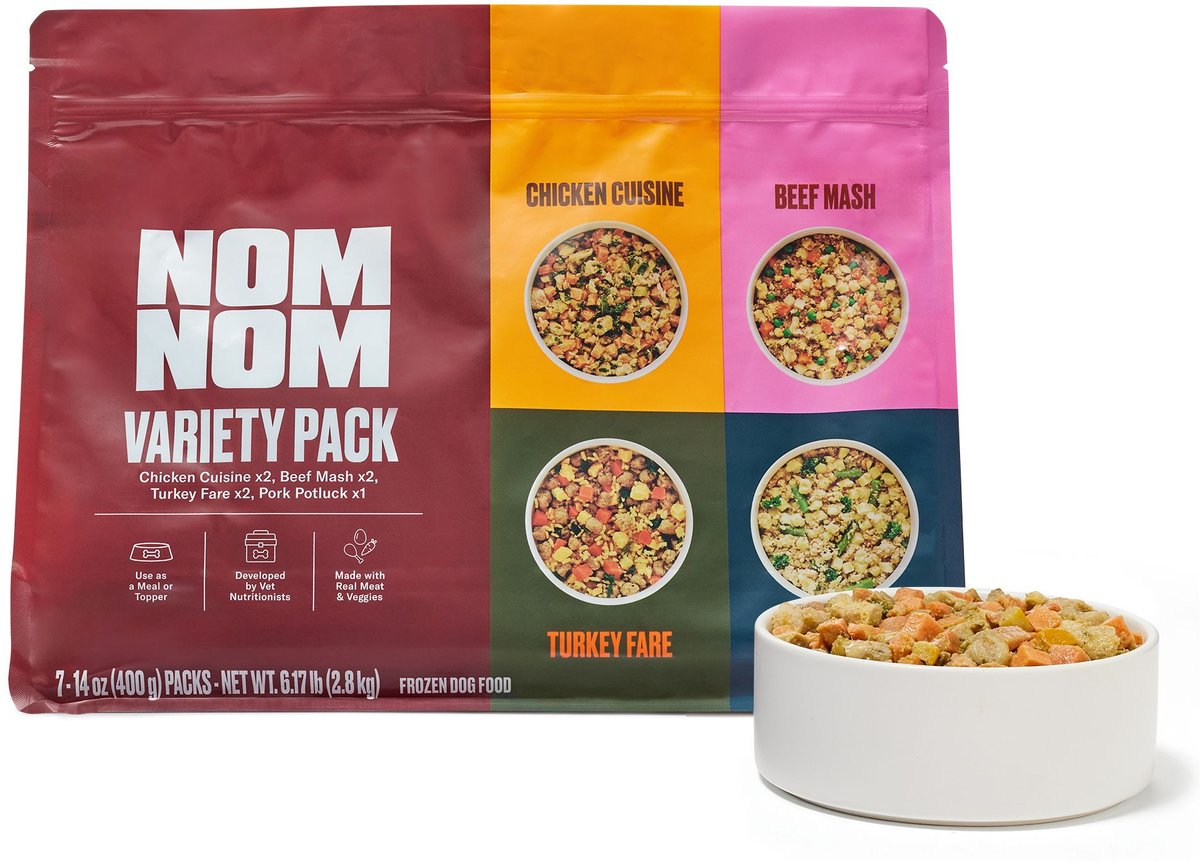
Nom Nom, founded in 2014 by Nate and Zach Phillips in the San Francisco area, has grown significantly and established a production facility in Nashville, TN, in 2018.
Acquired by Mars Petcare in January 2022, Nom Nom operates as an autonomous brand within Royal Canin, a division of Mars.
How it works
To use the service, you start by answering questions about your Pug’s age, weight, breed, activity level, and allergies to create a custom feeding profile.
Nom Nom will then provide samples and a quote based on your Pug’s needs. Once you proceed, a delivery schedule is set up for freshly cooked and frozen meals.
Options include Beef Mash, Chicken Cuisine, Pork Potluck, and Turkey Fare, all formulated by experienced veterinarians for optimal nutrition.
First 5 Ingredients
- Chicken Cuisine Recipe: Diced chicken, sweet potatoes, squash, spinach, sunflower oil
- Caloric Content: 570 kcal per lb
- Beef Mash Recipe: Ground beef, russet potatoes, eggs, carrots, peas
- Caloric Content: 563 kcal per lb
- Turkey Fare Recipe: Ground turkey, brown rice, eggs, carrots, spinach
- Caloric Content: 672 kcal per lb
- Pork Potluck Recipe: Ground pork, russet potatoes, green beans, squash, kale
- Caloric Content: 566 kcal per lb
- Suitable for which dogs: All breeds, from the small Maltese to Pugs and German Shepherds
- Storage: It will stay fresh for three months deep-frozen and eight days refrigerated once thawed.
- Key Benefits: The personalized gut health (microbiome) tests offered by Nom Nom Dog Food will give both you and Nom Nom a clearer picture of your dog’s needs. These tests were developed to ensure that your dog is getting all the support its sensitive digestive system needs.
- Price: The average cost for a Pug-sized dog is $6 per day.
What to Consider While Buying Dog Foods for Pugs?
The perfect diet for your Pug should be high-quality and nutrient-dense. Here are some dietary options:
- Kibble Diet: This processed food offers a balanced diet, meeting nutritional needs. It should include animal protein, grains, vitamins, minerals, and antioxidants.
- Wet or Canned Dog Food: With higher moisture content, this option is ideal for Pugs that drink less water or have health issues like urinary or kidney disease. Its flavor and aroma can entice picky eaters and is easier to chew for those with dental problems.
- Raw Diet: Fresh dog food delivery services provide meals made with whole ingredients like lean proteins and veggies. These foods meet AAFCO standards and help boost immunity and vitality.
- Home-Cooked Diet: Prepared meals should include various animal proteins and vegetables, tailored to your Pug’s needs. It’s essential to consult a veterinary nutritionist and use dietary supplements like Balance IT to ensure nutritional completeness.
What is the Ideal Daily Calorie Intake for Pugs?
An adult Pug typically weighs 14 to 18 pounds and needs about 40 calories per pound daily.
Puppies require around 50 calories per pound for growth. As Pugs age and become less active, reduce their caloric intake to prevent weight gain.
Consult your veterinarian for personalized advice.
Are There Foods to Avoid for Brachycephalic Dogs like Pugs?
Brachycephalic dogs are those with condensed snouts that often cause respiratory distress. Some brachycephalic breeds include:
- Boston Terriers
- English Bulldogs
- French Bulldogs
- Pugs
- Cavalier King Charles Spaniels
- Shar-Pei
- English Mastiff
- Shih Tzu
- Pekingese
Unlike most dogs with upper airways that enable air to pass freely through the trachea, the anatomy of brachycephalic dogs can present issues and hamper clear easy breathing.
Brachycephalic dogs have small mouths, and they frequently have overlapping teeth or baby teeth that do not fall out.
Tartar tends to build up quickly, with the resulting problems of gingivitis and other mouth disorders. They suffer from dental malocclusion and may have difficulty chewing their food.
Furthermore, the anatomy of brachycephalic dogs causes their small nostrils to press against the food bowl wall when they eat, causing them to inhale through their mouths while they eat.
That causes them to swallow a lot of air, explaining their frequent farting after meals. At the same time, tiny particles of food can enter the trachea when they inhale while eating.
Bottom Line:
Although Pugs and other brachycephalic dogs can eat most of the foods other dogs eat, their people-parents should monitor them closely during meal times to act if anything goes wrong.


